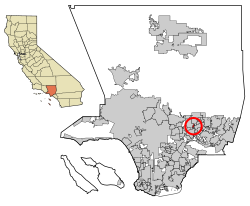2020
The 2020 United States census reported that Mayflower Village had a population of 5,402. The population density was 7,874.6 inhabitants per square mile (3,040.4/km2). The racial makeup of Mayflower Village was 32.1% White, 1.3% African American, 0.8% Native American, 39.8% Asian, 0.1% Pacific Islander, 11.9% from other races, and 14.0% from two or more races. Hispanic or Latino of any race were 27.9% of the population. [24]
The census reported that 99.7% of the population lived in households, 0.3% lived in non-institutionalized group quarters, and no one was institutionalized. [24]
There were 1,853 households, out of which 29.5% included children under the age of 18, 53.8% were married-couple households, 4.3% were cohabiting couple households, 26.4% had a female householder with no partner present, and 15.5% had a male householder with no partner present. 20.8% of households were one person, and 11.8% were one person aged 65 or older. The average household size was 2.91. [24] There were 1,376 families (74.3% of all households). [25]
The age distribution was 18.6% under the age of 18, 7.8% aged 18 to 24, 24.5% aged 25 to 44, 29.7% aged 45 to 64, and 19.4% who were 65 years of age or older. The median age was 44.0 years. For every 100 females, there were 90.8 males. [24]
There were 1,916 housing units at an average density of 2,793.0 units per square mile (1,078.4 units/km2), of which 1,853 (96.7%) were occupied. Of these, 76.8% were owner-occupied, and 23.2% were occupied by renters. [24]
In 2023, the US Census Bureau estimated that the median household income was $95,521, and the per capita income was $39,146. About 3.9% of families and 8.5% of the population were below the poverty line. [26]
2010
At the 2010 census Mayflower Village had a population of 5,515. The population density was 8,030.2 inhabitants per square mile (3,100.5/km2). The racial makeup of Mayflower Village was 2,929 (53.1%) White (37.1% Non-Hispanic White), [27] 83 (1.5%) African American, 28 (0.5%) Native American, 1,734 (31.4%) Asian, 4 (0.1%) Pacific Islander, 491 (8.9%) from other races, and 246 (4.5%) from two or more races. Hispanic or Latino of any race were 1,521 persons (27.6%). [28]
The census reported that 5,511 people (99.9% of the population) lived in households, 4 (0.1%) lived in non-institutionalized group quarters, and no one was institutionalized.
There were 1,905 households, 656 (34.4%) had children under the age of 18 living in them, 1,078 (56.6%) were opposite-sex married couples living together, 249 (13.1%) had a female householder with no husband present, 98 (5.1%) had a male householder with no wife present. There were 81 (4.3%) unmarried opposite-sex partnerships, and 9 (0.5%) same-sex married couples or partnerships. 385 households (20.2%) were one person and 177 (9.3%) had someone living alone who was 65 or older. The average household size was 2.89. There were 1,425 families (74.8% of households); the average family size was 3.34.
The age distribution was 1,197 people (21.7%) under the age of 18, 435 people (7.9%) aged 18 to 24, 1,433 people (26.0%) aged 25 to 44, 1,692 people (30.7%) aged 45 to 64, and 758 people (13.7%) who were 65 or older. The median age was 41.1 years. For every 100 females, there were 92.5 males. For every 100 females age 18 and over, there were 89.7 males.
There were 1,975 housing units at an average density of 2,875.7 per square mile, of the occupied units 1,559 (81.8%) were owner-occupied and 346 (18.2%) were rented. The homeowner vacancy rate was 1.0%; the rental vacancy rate was 6.0%. 4,464 people (80.9% of the population) lived in owner-occupied housing units and 1,047 people (19.0%) lived in rental housing units.
According to the 2010 United States Census, Mayflower Village had a median household income of $76,461, with 5.6% of the population living below the federal poverty line. [27]



